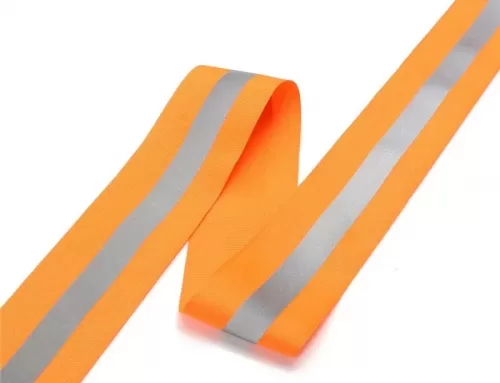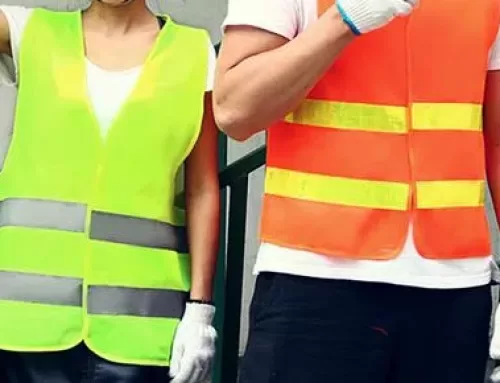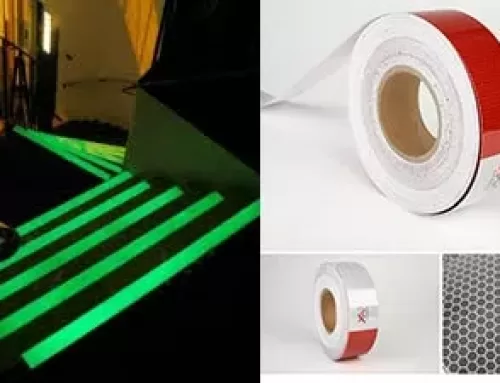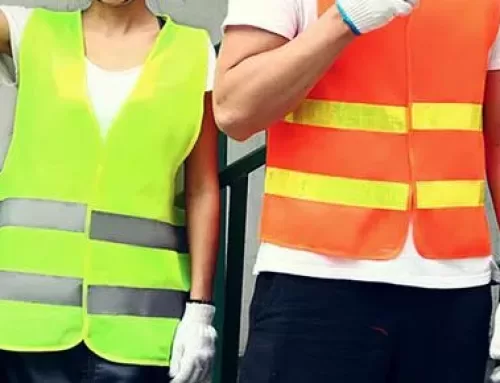Why Are Safety Vests Yellow?
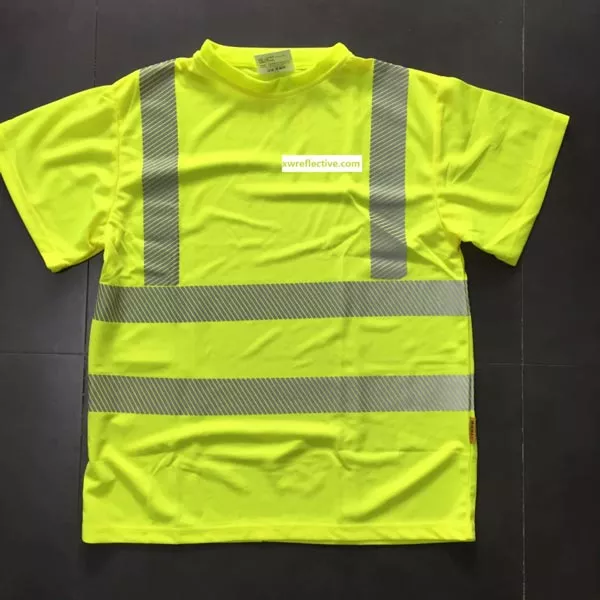
You may wonder why are safety vests yellow. The answer is simple: they increase the visibility of the wearer. The human eye does not readily detect blue because it has an undesirable wavelength. On the other hand, yellow is a color that attracts the attention of the human brain. That’s why most warning signs and hazard symbols are in this hue. The yellow color has many other benefits as well. It can help people recognize and avoid dangerous situations where they might need to use high-visibility clothing.
Class 2 reflective vests
ANSI Type R Class 2 safety vests are made to meet the highest standards of visibility on the job site. These vests have additional high-visibility materials that provide even more visibility. Because of this, they may allow designers to use more high-visibility materials to enhance the vest’s design. The color yellow is the most widely used choice among workers, especially those in traffic-heavy work zones. In addition to this, workers wearing these vests are required by MTA rules to wear them.
The majority of workers need class 2 safety vests. These are reserved for workers in high-traffic areas, including road construction and demolition. They should be extremely visible when working near roads or railroad tracks.
ANSI safety vests must be one of two colors: orange or yellow. Whether you choose orange or yellow, it’s important to have enough reflective tape. Remember, 155 square inches of reflective tape are required. Your safety vest should have reflective strips that wrap around the middle and over each shoulder. Class 2 reflective vests are yellow, but they do not have sleeves. This is to protect your shoulders. When choosing your safety vest, it’s important to check the measurements and the type of tape.
The main purpose of class 2 safety vests is to increase the visibility of workers in low-visibility environments. They are required to wear reflective vests where traffic flow exceeds 25 mph and visibility is poor. ANSI safety vests are most commonly worn by airport personnel, airport baggage handlers, and school crossing guards. The reflective striping must cover 201 square inches of the vest. ANSI safety vests are designed for employees working in areas where visibility is poor.
Class 3 reflective vests
Among the many different colors available for safety vests, yellow is the most prominent. Class 3 safety vests are typically worn by workers in areas of high traffic and heavy machinery. They are also recommended for applications where increased visibility is necessary, such as road construction and emergency response personnel. These reflective safety vests are highly visible in the field, and comply with all ANSI safety requirements.
ANSI safety standards require all workers to wear safety vests. These vests have high-quality materials and are designed to provide comfort and safety for workers. This means they are made to provide maximum protection against hazards while remaining comfortable and breathable. They also comply with OSHA and ANSI safety standards, ensuring worker safety and protection. They come in many different colors, including orange and lime yellow. While orange may be the more popular choice, yellow vests have a range of features to make them a better fit for different purposes.
A bright safety vest can save the life of road workers by making them more visible to motorists. Fortunately, there are many trusted brands of fluorescent vests on the market. Class 3 safety vests are constructed with polyester mesh and have a zipper front closure and two-inch reflective stripes. They are especially important for night crews or those whose visibility is compromised when drivers use their headlights. So, if you work in a construction site or on the road, a bright yellow safety vest is an essential safety item.
What are the benefits of wearing a safety vest? ANSI safety vests are designed to give workers maximum visibility and conspicuity. They allow workers to be recognized by drivers, pedestrians, and other road users. ANSI class 3 reflective vests are the most visible safety vests, with more than 310 square inches of reflective tape on the backside. Often, these vests resemble a short-sleeve t-shirt.
Class 1 reflective vests
When it comes to choosing reflective vests, yellow and orange are a solid match for the safety requirements for workers. Class 1 safety vests should have at least 155 square inches of reflective tape and background of at least 1240 square inches. The reflective tape must be placed on the chest, shoulders, arms, and legs. The reflective tape should be at least one inch wide and must wrap around the center of the chest, over the shoulders, and over the shoulders of both the left and right arms.
These vests can be used in many different industries. Some of these vests are made for work that is in low-risk environments, such as parking attendants, delivery workers, and warehouse employees. In suburban cul-de-sacs, these safety vests are a good start when it comes to visibility at work sites. Although class 1 vests do not have reflective tape, they do contain strips in strategic locations.
Another color option is class 3 safety vests. Class 3 vests are typically a combination of solid polyester and mesh material. The mesh material adds breathability and is ideal for warm climates. Other colors include orange and lime. You can find one that fits your needs and budget! There are also vests designed for workers near roads at night. And, of course, you can find reflective vests for a variety of different environments and professions.
When choosing a reflective vest, remember that class 1 is made for the lowest risk jobs. When you’re working in areas where traffic flow is low or steady, the yellow vests are the right choice for this type of work. For example, workers performing sidewalk repairs in a quiet neighborhood may benefit from a class 1 vest. However, if you’re performing a high-risk task, you should consider a different type of vest.
Class 2 hi-vis vests
High visibility, or hi-vis, vests are an important safety accessory for many professions. These vests meet or exceed the standards set by the American National Standards Institute. These vests are designed to enhance worker visibility in low-light situations and on roadways. They are also ideal for public safety purposes such as identification of first responders or construction workers. Hi-vis vests come in a wide range of styles and colors, from solid hi-vis to reflective mesh and surveyor styles.
ANSI class 2 hi-vis vests are designed for employees in high-risk environments, such as construction, highway work, and road maintenance. They provide a margin of safety, especially in inclement weather. These vests are also mandatory for workers working in environments where vehicles travel over 25 mph. For example, workers on construction sites, utility crews, road crews, survey crews, law enforcement, school crossing guards, and toll gate employees are all required to wear class 2 safety vests.
While many workers are required by law to wear high-vis gear, many also choose to do so as a matter of personal preference. OSHA has translated federal regulations relating to road work zone safety to state-by-state requirements, which require highway workers to wear hi-vis vests while on the job. ANSI regulations also specify the amount of retroreflective material that must be present on the front and back of the garment when laid flat. This ensures worker visibility in both directions, reducing the risk of on-the-job accidents and injuries.
The reason for the difference between Class 1 and Class 2 hi-vis is simple: these vests are larger and incorporate a specific amount of background material. ANSI Class 2 safety vests require seventy-seven-seven-seven-square-inch safety yellow or orange background and 201 square inches of retroreflective striping. These vests are required for workers who work near heavy machinery.
Class 1 hi-vis vests
To be considered a class one hi-vis worker, you should wear a bright yellow or orange vest. It must be fitted with a high-visibility stripe or reflective tape measuring 155 square inches. Reflective tape is typically placed as 360-degree stripes around the middle of the vest. The reflective tape should also cover the shoulders and arms. When selecting a hi-vis vest, the size, color, and type of reflective tape are important considerations.
While all high-vis clothing is important in various work environments, Class 1 vests are the most visible. Because they are made of high-visibility materials, they are highly visible to distracted drivers. Class 1 hi-vis vests are yellow, while class 2 and class 3 vests are green. Listed below are some of the most common colors for high-vis vests. To understand how much brightness you need, consider how often you will need the hi-vis clothing.
Type P hi-vis vests are available in three different types. Class P vests are shorter and have more retro-reflective materials. Type P vests are often more breathable than Class 1 vests and are perfect for Class 2 environments where a worker may be at risk for falls. These vests are made in North Carolina and typically have a lead time of two weeks. If you need to order less than 300 pieces, you can expect a delivery time of two weeks.
ANSI safety vests must be made of two materials. The background material is a fluorescent-colored fabric. Retroreflective material is made from reflective striping. Retroreflective vests do not retain the high visibility that they have during the day. They are not as good at enhancing your safety if they are made of fluorescent materials. A yellow vest will reflect light better than a black one. You should also ensure that the vest has enough contrast in its color scheme to help you be seen from afar.

